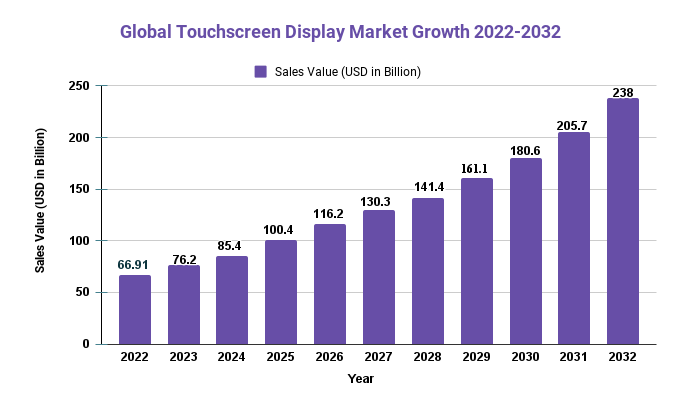Touchscreen Display Market Size Worth USD 238 Billion by 2032

Page Contents
Market Overview
Published Via 11Press: The Touchscreen Display Market size is expected to be worth around USD 238 Bn by 2032 from USD 66.91 Bn in 2022, growing at a CAGR of 13.9% during the forecast period from 2022 to 2032.
The touchscreen display market has seen tremendous growth over the last several years and is expected to keep expanding in the coming years. A touchscreen display enables users to interact with a device by touching it directly on the screen it is commonly found in smartphones, tablets, laptops, and other electronic gadgets.
One of the primary drivers of the touchscreen display market is an increase in smartphone and tablet ownership. As more people rely on these devices for personal and professional purposes, there has been an uptick in demand for high-quality, responsive touchscreen displays.
Another factor driving the market is the growing acceptance of touch-based interfaces in various industries such as healthcare, automotive, and retail. Touchscreen displays are being employed to create more intuitive and engaging user experiences in these sectors.
The market is being driven by technological developments, such as flexible and foldable displays that open up new possibilities in device design and user experience.
The leading companies in the touchscreen display market include LG Electronics, Samsung, Fujitsu, Philips, Nichia, Seoul Semiconductor, Epistar, NEC, AOC, 3M, Sharp, Palas, Oasis Touch Technologies
Overall, the touchscreen display market is expected to experience steady growth as demand for these displays grows and new technologies emerge that enhance their performance and functionality.
Request For Sample Report Here: https://market.us/report/touchscreen-display-market/request-sample/

Key Takeaways
- Growing Demand: The touchscreen display market has experienced significant expansion due to the increasing demand for touch-enabled devices across various industries, such as healthcare, retail, automotive, and consumer electronics.
- Technological Advancements: Technological advancements in the field of touchscreens, such as flexible displays, multi-touch technology, and the integration of haptic feedback are further fueling the market growth.
- Rising smartphone adoption: The increasing popularity of smartphones, tablets, and other mobile devices is one major factor driving growth in the touchscreen display market. These devices use touchscreens as their primary input method and as their popularity continues to expand, so does the demand for these screens.
- The emergence of New Applications: With the rise of virtual and augmented reality applications, touchscreens are becoming more essential than ever before. They're being utilized in education, gaming, and other industries to enhance user experiences.
- Asia Pacific Region: The Asia Pacific region is expected to experience rapid growth in the touchscreen display market due to the presence of major electronic device manufacturers like Samsung, LG, and Sony in this region.
Regional Analysis
- The North American region is a major market for touchscreen displays due to the widespread adoption of advanced technologies and the presence of major manufacturers. The United States leads this region, followed by Canada and Mexico.
- Europe is a significant market for touchscreen displays due to the presence of major automotive and consumer electronics companies in the region. Germany, France, and the United Kingdom are three key markets within Europe.
- The Asia Pacific region is expected to be the fastest-growing market for touchscreen displays due to the presence of major electronic device manufacturers like Samsung, LG, and Sony in this area. China, Japan, and South Korea are three major markets within this region.
- The Latin American market for touchscreen displays is expanding due to an uptick in the smartphone, tablet, and other mobile device sales throughout the region. Brazil, Mexico, and Argentina are the three main markets within Latin America.
- The Middle East and Africa market for touchscreen displays is expected to expand due to the rising demand for consumer electronics products and the increasing adoption of digital technologies in the region. Saudi Arabia, South Africa, and the UAE are three major markets within this region.
- Overall, the Asia Pacific region is expected to experience rapid growth in the market for touchscreen displays due to the presence of major electronic device manufacturers there and an increasing adoption rate for smartphones and tablets.
Browse the summary of the report and Complete the Table of Contents (TOC)
Drivers
- Growing Demand for Touch-Enabled Devices: The growing demand for touch-enabled devices across various industries, such as healthcare, retail, automotive, and consumer electronics is propelling the growth of the touchscreen display market.
- Rising Adoption of Smartphones and Tablets: The growing popularity of smartphones, tablets, and other mobile devices is one major driver for the touchscreen display market. These devices use touchscreens as their primary input method, driving up demand for touchscreen displays in response.
- Technological Advancements in the field of touchscreens, such as flexible displays, multi-touch technology, and the incorporation of haptic feedback are further fueling growth in this market.
- The emergence of New Applications: With the advent of virtual and augmented reality applications, touchscreens are becoming more crucial than ever before. They're being utilized in education, gaming, and other industries to enhance user experiences.
- Increasing Demand for Interactive Displays: The demand for interactive displays is on the rise in various industries such as education, entertainment, and hospitality, propelling growth in the touchscreen display market.
- Government Regulations mandating the use of touchscreens in certain industries, such as healthcare, are further propelling growth within this market.
- Overall, the growing demand for touch-enabled devices, the rising adoption of smartphones and tablets, technological advancements, and new applications are the major driving forces in the touchscreen display market.
Restraints
- High manufacturing costs: The manufacturing cost of touchscreen displays is relatively high compared to other display technologies, which may hinder the growth of the market, especially in price-sensitive markets.
- Issues with durability: Durability is one of the biggest challenges faced by the touchscreen display market. Touchscreens are prone to scratches, cracks, and other forms of damage, which may lead to decreased performance or even failure.
- Integration challenges: The integration of touchscreens into certain devices can be challenging, which may limit their adoption in certain industries.
- Limited tactile feedback: The lack of tactile feedback in touchscreens can be a challenge for some users, especially in certain applications such as gaming and typing.
- Competition from alternative technologies: The touchscreen display market faces competition from alternative technologies such as voice recognition, gesture recognition, and eye-tracking, which may limit its growth in some applications.
- Overall, the high manufacturing costs, issues with durability, integration challenges, limited tactile feedback, and competition from alternative technologies are some of the restraints of the touchscreen display market that may hinder its growth in the future.
Opportunities
- Development of Flexible Touchscreens: The advent of flexible touchscreens offers the touchscreen display market an opportunity to expand into new applications and industries, such as wearables and flexible displays.
- Integration of Haptic Feedback: The incorporation of haptic feedback in touchscreens presents a market opportunity to enhance user experience and maximize touchscreen functionality in applications such as gaming, virtual/augmented reality, and automotive.
- The growing demand for large-sized touchscreens in applications such as education, entertainment, and retail offers the market an opportunity to expand into new industries and uses.
- Adoption of touchscreens in industrial and commercial applications, The growing use of touchscreens in industrial and commercial settings such as healthcare, transportation, and hospitality offers the market an opportunity to expand beyond consumer electronics into new sectors.
- Increasing Demand for Touchscreens in Emerging Markets: The growing popularity of touchscreens among emerging markets such as India, China, and Southeast Asia provides the industry with an opportunity to expand into new geographies and reach new customer segments.
- Overall, the development of flexible touchscreens, integration of haptic feedback, rising demand for large-sized touchscreens, adoption of touchscreens in industrial and commercial applications, as well as rising interest in touchscreen displays in emerging markets present numerous growth and innovation prospects for this market.
Challenges
- Price pressure: The touchscreen display market faces price pressure from alternative technologies such as voice recognition, gesture recognition, and eye-tracking, which may limit its growth in some applications.
- Technological limitations: Despite significant advancements in touchscreens technology, there are still some technical limitations such as sensitivity, accuracy, and durability, which may hinder the growth of the market in some applications.
- Health concerns: There are growing concerns about the health effects of prolonged exposure to touchscreen displays, especially in children, which may lead to regulatory challenges and limitations on the use of touchscreens.
- Supply chain disruptions: The touchscreen display market faces supply chain disruptions due to factors such as geopolitical tensions, natural disasters, and the COVID-19 pandemic, which may impact the availability and pricing of touchscreen components.
- Intense competition: The touchscreen display market is highly competitive, with several established players and new entrants competing for market share, which may limit the growth and profitability of some players.
- Overall, price pressure, technological limitations, health concerns, supply chain disruptions, and intense competition are some of the key challenges faced by the touchscreen display market that may hinder its growth and development.
Recent Development
- In-display fingerprint technology: This technology allows users to unlock their smartphones by placing their fingers on the screen. It eliminates the need for a separate fingerprint sensor, making the phone design sleeker.
- 5G Touchscreens: The combination of 5G technology and touchscreen displays is expected to bring about new opportunities for businesses in various sectors such as healthcare, retail, and entertainment.
- Haptic feedback: Some touchscreen displays now feature haptic feedback, which provides physical feedback when the user interacts with the screen. This technology can improve the user experience, making touchscreen displays more intuitive and engaging.
- OLED displays: OLED displays are becoming more popular in the touchscreen display market due to their high contrast ratio, excellent color reproduction, and energy efficiency.
Report Scope
| Report Attribute | Details |
| The market size value in 2022 | USD 66.91 Bn |
| Revenue forecast by 2032 | USD 238 Bn |
| Growth Rate | CAGR Of 13.9% |
| Regions Covered | North America, Europe, Asia Pacific, Latin America, and Middle East & Africa, and the Rest of the World |
| Historical Years | 2017-2022 |
| Base Year | 2022 |
| Estimated Year | 2023 |
| Short-Term Projection Year | 2028 |
| Long-Term Projected Year | 2032 |
Key Market Segments
Type
- Capacitive
- Resistive
- Infrared
- Surface Acoustic Wave
- Other
Application
- Consumer Electronics
- Healthcare
- Banking & Finance (BFSI)
- Other
Key Market Players included in the report:
- LG Electronics
- Samsung
- Fujitsu
- Philips
- Nichia
- Seoul Semiconductor
- Epistar
- NEC
- AOC
- 3M
- Sharp
- Palas
- Oasis Touch Technologies
Frequently Asked Questions
What is the market study period?
The Touchscreen Display Market is studied from 2017 – 2032.
What is the growth rate for the Touchscreen Display Market?
The Touchscreen Display Market is growing at a CAGR of 13.9%
Who are the major players in the Touchscreen Display Market?
LG Electronics, Samsung, Fujitsu, Philips, Nichia, Seoul Semiconductor, Epistar, NEC, AOC, 3M, Sharp, Palas, Oasis Touch Technologies
The team behind market.us, marketresearch.biz, market.biz and more. Our purpose is to keep our customers ahead of the game with regard to the markets. They may fluctuate up or down, but we will help you to stay ahead of the curve in these market fluctuations. Our consistent growth and ability to deliver in-depth analyses and market insight has engaged genuine market players. They have faith in us to offer the data and information they require to make balanced and decisive marketing decisions.